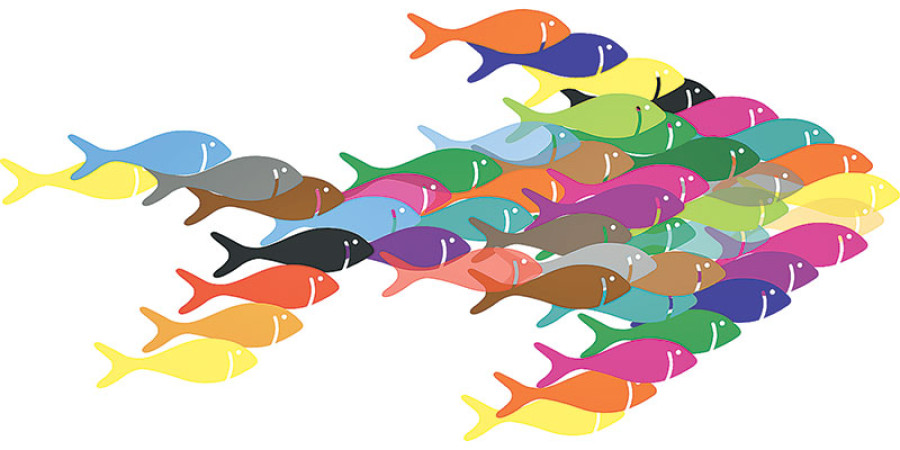Miscellaneous
Sum of its parts
It is a fact that the break away, disintegration and formation of splinter groups in the name of ideological differences and revisionism is a common phenomenon in left (communist) parties all over the world; and the plethora of such splinter groups in Nepal very much validates this fact.
It is a fact that the break away, disintegration and formation of splinter groups in the name of ideological differences and revisionism is a common phenomenon in left (communist) parties all over the world; and the plethora of such splinter groups in Nepal very much validates this fact. The underlying cause of such disintegration into meaningless splinter groups or the so-called new revolutionary parties (as the splinter groups claim to be) is often more about self-aggrandisement of individuals aspiring for leadership rather than ideological differences.
This trend is so pervasive in Nepal that even when these splinter groups have become obsolete and irrelevant, they continue to echo their ideological cacophony. Even today, there are more than ten such splinter groups in Nepal, more than four from the Prachanda-led former Maoist Centre (MC) alone. In this backdrop, interestingly, two major left political forces (UML and MC) merged to become the largest communist party in the country. This is, indeed, a historic development with far-reaching political repercussions.
Political stability
The newly-formed party (CPN) from the fusion of UML and MC can certainly be seen as a welcome development, especially when the country has been plagued by endemic political instability for over three decades. We all know that political stability is the precondition for everything a nation state and its people aspire to achieve—including growth, development, prosperity and good governance. Whereas political instability breeds rampant corruption, breakdown of law and order, criminalisation of politics and social and moral degradation of judges, politicians, the business community, civil servants and bureaucrats. Nepalis have witnessed and have gathered ample experiences of such malignant practices over the last three decades. How long can such a mismanaged country sustain itself?
The onus now lies on KP Oli and PK Dahal to prove that this unification is in the interest of the nation and its people. The two parties formed the left alliance during the elections in December last year and appealed the people to vote for their common agenda of political stability, good governance, development and prosperity. People overwhelmingly supported their agenda in the federal and provincial elections and consequently the party won nearly two-third majority seats.
Had this unification not occurred, it could be argued that the country would have been subjected to many more years of instability and political mismanagement. Contrary to the expectation of many political pundits, Oli and Dahal made an expedient move in unifing the two parties, taking their domestic and foreign detractors by surprise. It is certainly a positive development in the sense that it ensures political stability and the government can now focus its attention on development works that can lead to prosperity.
Skepticism
Following the unification, analysts, supporters and the critics have expressed their skepticism about the stability and the longevity of the newly-united party. One important question that comes to mind is how the chemistry between cadres of the MC and the UML and their respective leaders will pan out. Unity in its early days may glitter with promise but maintaining this sheen will be a challenging task for the two chairmen.
Another equally important question is what modus-operandi will be adopted in order to accommodate two chairmen in one party. How will they conduct their party business and maintain the chain of command and resolve the differences that might arise from a number of internal organisational issues related to integration and functioning of the party organs and various party affiliated organisations (students, farmers, youth women, teachers and trade unions etc)? This is going to be a test of both Oli and Dahal’s leadership capabilities and the vision with which they have merged the two parties. These skepticisms should not be dismissed simply as an undue concern.
Historic opportunity for Congress
Nepali Congress (NC), particularly the Deuba-faction, perhaps did not expect this unification to go through as quickly as it did. However, one of the effects of the unification is that it gives the NC a historic opportunity to revisit its past legacy, revive its ideology and revitalise its organisational structures. NC is the oldest democratic party in the country and has had the opportunity to govern for quite a long period, during which it formed three majority governments. NC governments’ policies and modus-operandi, however, did not deliver the expected results and in many instances proved counterproductive for the country and its people.
NC has a broad-based constituency but this constituency has seemingly become fragmented. One of the most important things NC should do now is to consolidate its fragmented constituency and support base. The NC leaders should concentrate their efforts and energy in reinvigorating their constituency and support-base with new visions and strategies that can challenge the ruling NCP. NC cadres and supporters must realise that the present leadership (senior leaders) must be replaced by young leaders who can inspire and reinvigorate the constituency with new optimism. Sooner this happens, the better the prospect of NC bouncing back. To that end, the NC should stop being reactive and proactively pursue progressive agendas. This, in turn, will not only do the NC good but will be beneficial for the country and for competitive democratic polity. Let us hope that the creation of NCP becomes a headwater for political stability, good governance and healthy and democratic political competition.
Upreti is a retired Tribhuvan University professor




 5.44°C Kathmandu
5.44°C Kathmandu









